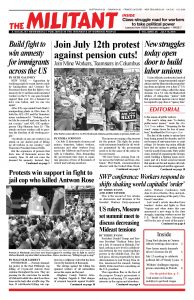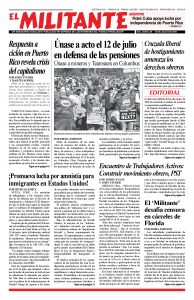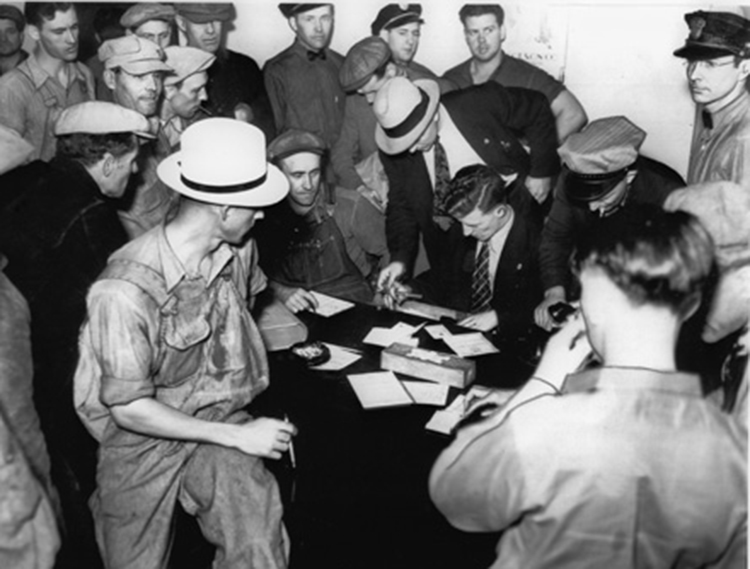Below is an excerpt from the “Afterword” to the new, enhanced edition of Teamster Bureaucracy, the last of four books by Farrell Dobbs on how Socialist Workers Party members and other militant workers engaged in a series of strike battles in the 1930s that forged a class-struggle union and broader politically minded labor movement in the Minneapolis trucking industry and spearheaded an organizing campaign among over-the-road drivers in the upper Mississippi Valley. Dobbs, a central leader of these battles, later served as both labor secretary and national secretary for the SWP. As President Roosevelt made preparations for the U.S. rulers’ entry into the second imperialist World War, the Minneapolis Teamsters led an anti-war campaign in the union movement, leading Roosevelt’s attorney general to bring frame-up charges of sedition against leaders of both the union and the party. Copyright © 1977 by Pathfinder Press. Reprinted by permission.
[T]he class-struggle program needed by the trade unions should be introduced realistically on a transitional basis. In that way the unfolding labor radicalization can be guided from its present stage toward higher forms of development along the following lines:
Proposals for immediate action should center on problems involving the workers’ urgent material needs and the defense of their democratic rights. It is also important that the fight around those issues be attuned to the existing levels of consciousness in the union membership. Then, as significant forces are set into motion through that approach, several things take place. Rank-and-file militancy rises. Increasingly sharp clashes with the bosses result, during which the workers begin to shed class-collaborationist illusions and acquire class-struggle concepts. Lessons thus learned during industrial conflicts can prepare the union ranks for an advance toward action on a political plane. In short, a foundation is laid from which to initiate transformation of the trade unions themselves into instruments capable of developing far-reaching revolutionary perspectives.
As the transitional process from where they are to where they should be continues, the workers’ attention can be focused on broad questions which go far beyond day-to-day issues on the job. They will learn in that way to generalize their thinking in class terms, and the development of a conscious anticapitalist outlook will follow.
If, during the course of their experiences in struggle, the labor militants are helped to analyze the causes of the social and economic ills facing them; if they are aided in perceiving the essence of an outlived capitalism—they will learn that the existing problems are not incidental and episodic at all, but the consequence of a deep structural crisis of the system. They will then see why governmental control must be taken away from the capitalists by labor and its allies.
Basic to such a rise in the workers’ class consciousness is understanding that a fundamental change must take place in the role of the trade unions, which constitute the existing form of mass organization among the workers in this country. These broad instruments of struggle must be turned away from reliance upon so-called friends among the capitalist politicians. They must break off the self-defeating collaboration with the bosses’ government, that has been imposed by bureaucratic misleaders. The unions must be transformed into mechanisms for independent and militant action by the workers all along the line. Restrictions on the right to strike must be vigorously opposed and freedom to exercise that right firmly asserted. Internal union democracy must be established so that all questions can be decided on the basis of majority rule. Then, and only then, will organized labor manage to bring its full weight to bear in confrontations with the employers at the industrial level.
Whenever conflicts of significant magnitude erupt within industry today, the government intervenes on the employers’ side; and this interference is bound to intensify as capitalist decay gets worse. From this it follows that trade union action alone will prove less and less capable of resolving the workers’ problems, even on a limited basis. Objectively, industrial conflicts will assume more and more a political character, and even the most powerfully organized workers will be faced with an increasingly urgent need to act on the new and higher plane of politics.
Therefore, efforts to build an effective left wing in the trade unions will run into insurmountable obstacles unless the workers move toward resolving the problem of political action. A vigorous campaign must be conducted to break the labor movement from subordination to capitalist politics and to launch an independent labor political organization. This campaign will have to focus initially on educational propaganda for a change in labor’s political course, but it should not be conducted in an abstract, routine manner. Ample opportunity will be found to concretize the propaganda by drawing the lessons of setbacks caused by the misuse of labor’s inherent political strength. This can lay the basis for an advance, as soon as it becomes realistic, to an agitational campaign designed to convince the ranks of the urgency of forming a labor party.
In the process of creating their own mass party, based upon and controlled by the trade unions, the organized workers can draw unorganized, unemployed, and undocumented sections of their class into a broad political alliance. Labor will then be in a position to act both in a more unified manner and through advanced forms of struggle.
The workers will learn to generalize their needs, as a class, and to address their demands on a political basis to the capitalists, as a class. Political confrontation of that kind — for example, the nationalization of a given industry under workers’ control — will raise labor action as a whole to a higher plane and at the same time impart new vigor to the continuing trade union struggles. Increased militancy within industry will serve, in turn, to reinforce activity in the political sphere. In that way interacting processes will develop through which the workers will attain greater class consciousness, more complete solidarity, and, hence, mounting ability to outfight the bosses.
Before unity of the exploited masses can be attained, however, still another of organized labor’s existing policies must be thoroughly reversed. The labor movement must champion and give unqualified support to the demands of the Blacks, Chicanos, Puerto Ricans, Indians, and other oppressed national minorities and of women and youth.
As Leon Trotsky insisted in discussions during the 1930s, the American workers must learn to act politically and to think socially if they are to attain the class consciousness and solidarity needed to defeat the exploiters. This is the opposite of the narrow class-collaborationist course pursued by the labor bureaucracy. …
At every juncture in the unfolding social conflicts, the workers and their allies need guidance from a revolutionary socialist party. That is the reason for the existence of the Socialist Workers Party. Its scientific analysis of the class struggle provides in fullest measure the political consciousness and program that the anticapitalist movement must have. Therefore, it is uniquely qualified to shape the basic proposals, broad strategy, and tactical steps required for the most effective mass action.
In the course of events, increasing numbers of militants who come to recognize those facts will be ready to join in building such a party on an expanding scale, as they did in Minneapolis during the 1930s. As members of the revolutionary party, they will learn fundamentals involved in the fight against capitalist exploitation as well as lessons of past class struggles on a world-historical scale. Through that education they will become better equipped to apply valid principles in today’s conflicts. Their capacity will become enhanced to exert helpful influence within the broad mass movement in ways that will add to its efficiency in action, to its prospects for ultimate victory.
Such growth in the numerical strength and influential role of the revolutionary socialist party is, in the last analysis, decisive for the acquisition of supreme power in the United States by the workers and their allies; for only that kind of politically advanced formation, geared for combat in a scientific way, can lead the masses successfully in defeating the capitalists and their repressive apparatus.
It will then be possible to assume governmental power through assertion of majority rule, after which economic and social relations can be reorganized on a rational basis. An enlightened society can be constructed along socialist lines, in which there will be peace, freedom, equality, and security for all.
As the Teamster story demonstrates, the principal lesson for labor militants to derive from the Minneapolis experience is not that, under an adverse relationship of forces, the workers can be overcome; but that, with proper leadership, they can overcome.


